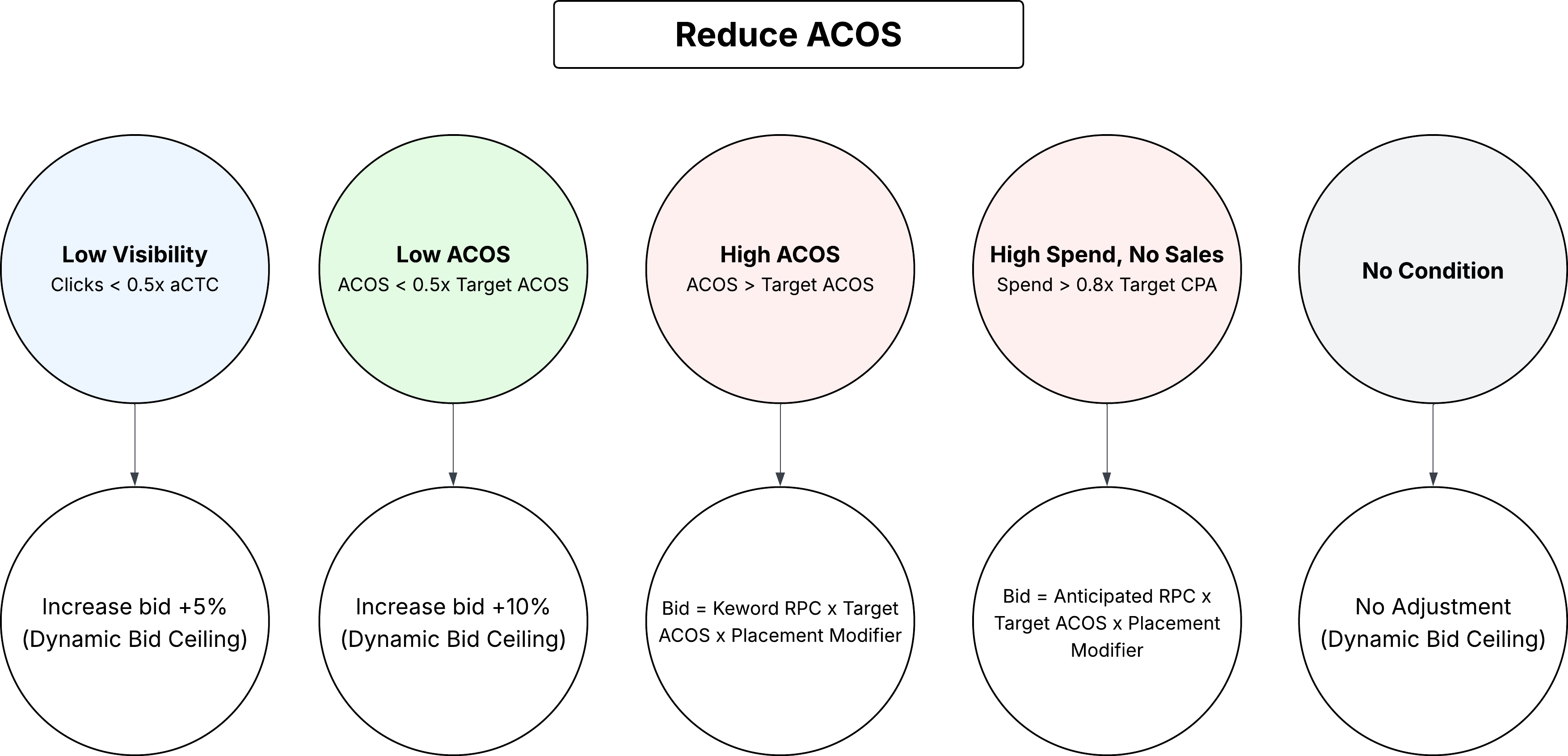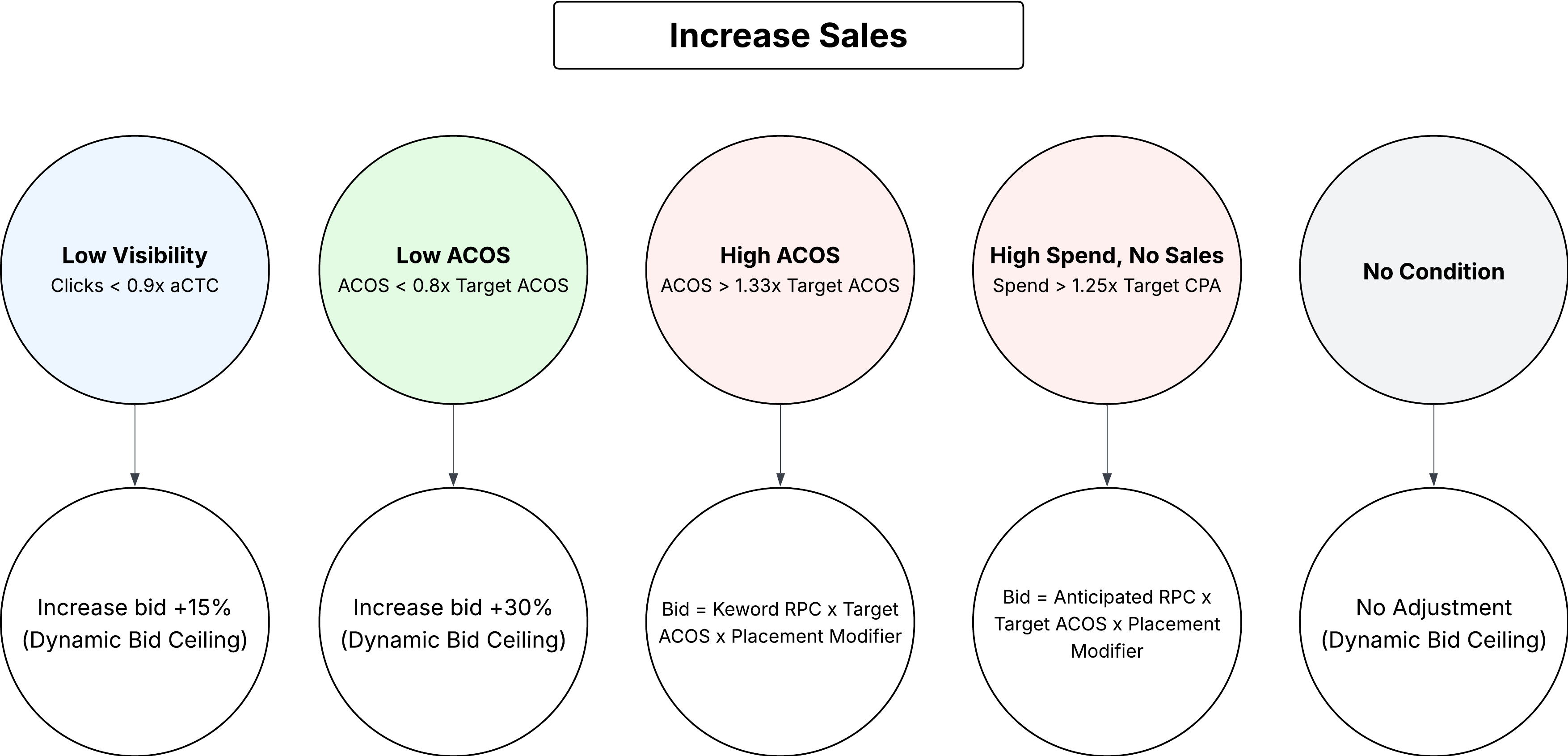Right-click here to open in new tab.
When using other PPC bidding tools, we always felt in the dark about what was happening to our bids (and why).
The “black box algorithm” of AI tools made it impossible to know how to adjust the settings to get the results we promised clients. And the "two week learning curve" narrative wasn't satisfactory when performance wasn't there.
So when we started AdLabs, it was pivotal that we practice "white box" principles to let you know exactly what to expect from the bid optimizer so you can better wield it to drive the best performance possible for your accounts.
The guiding principle for all our optimizations is the Revenue-Per-Click (RPC) bidding method.

We optimize bids when keywords fall under any of the 4 criteria:
High ACOS
High Spend, Non-Converting
Low ACOS
Low Visibility
You can learn more about our rationale for optimizing based on these criteria in Episode 2 of That Amazon Ads Podcast:
The specific adjustments for each of the above scenarios changes slightly depending on the prioritization you choose when optimizing. We have three prioritizations:
Balanced
Reduce ACOS
Increase Sales
The 4 different keyword adjustments across 3 unique prioritizations allows for 12 possible types of bid adjustments (4 * 3 = 12).
Let's take a closer look at each of these to see the triggers for each condition and their corresponding bid adjustments. I recommend reading the "Balanced Prioritization" thoroughly, as the details in "Reduce ACOS" and "Increase Sales" are predicated upon it.
This is our "Standard Optimization Procedure," designed to scale revenue without exceeding your Target ACOS.

If a keyword's ACOS exceeds your Target ACOS by 20%, we will calculate what the keyword bid should be in order to hit the Target ACOS using the "Revenue Per Click" (RPC) method. You can read more about the RPC bidding method here.
Example:
Target ACOS = 30%
"High ACOS" threshold = 20% higher than 30% (i.e., 36%)
If a keyword's ACOS exceeds 36%, the bid will be calculated based on the keyword's RPC * Target ACOS
Most of the time, this optimization results in reducing the keyword's bid.
However, you may sometimes see that a bid increases from it's current value even though it is a "High ACOS" keyword. This is nothing to be concerned about, as the "current bid" isn't an actual data point but rather a status (e.g., you could have reduced the bid to $0.02 just a few minutes earlier, but that current bid has nothing to do with the keyword's performance for the selected date range).
The "new bid" for a High ACOS keyword will always be lower than the keyword's CPC for the selected date range as we optimize to hit the target ACOS.
We calculate what your Target Cost Per Acquisition (Target CPA) should be based on your Target ACOS and Average Order Value (AOV):
Target CPA = Target ACOS * AOV
If spend on a keyword exceeds your Target CPA without earning a sale, we know that bid is already too high given the current performance. We will calculate the bid based on Anticipated Revenue Per Click, by referencing the Ad Group's average conversion rate and AOV. This topic is also discussed in our article on the RPC bidding method.
Example:
Target ACOS = 30%
AOV = $20
Target CPA = 30% * $20 (i.e., $6)
"High Spend" threshold = $6.00
If a keyword's spend exceeds $6.00 and has no sales, the bid will be calculated based on the keyword's Anticipated RPC * Target ACOS
After years of testing, we have found that bid increases are best executed via small increments rather than large jumps. So if a keyword has at least one sale and the ACOS is 20% below your Target ACOS (or lower), we will increase the bid by 20%.
Example:
Target ACOS = 30%
"Low ACOS" threshold = 20% lower than 30% (i.e., 24%)
If a keyword's ACOS is below 24%, we will increase the bid by 10%
We classify "low visibility keywords" as those which have fewer clicks than is necessary to earn a sale. We call this our average Clicks-to-Conversion (aCTC) which is calculated as Clicks divided by Orders. In the Balanced prioritization, if a keyword has 10% fewer clicks than the aCTC, we will increase the bid by 10%.
Example:
Average Clicks-to-Conversion = 10 clicks
"Low Visibility" threshold = 10% fewer than 10 clicks (i.e., 9 clicks)
If a keyword has fewer than 9 clicks, we will increase the bid by 5%
It is possible for a keyword to fall under both the Low Visibility and Low ACOS conditions (e.g., a keyword with 1 click and 1 sale). In these scenarios, the "Low ACOS" condition trumps and the keyword will be optimized accordingly.
This prioritization uses the same logic and guiding principles as the "Balanced" approach, but emphasizes opportunities to reduce ACOS more quickly.

Whereas the Balanced prioritization allows for a keyword's ACOS to get up to 20% over target before optimizing, the "Reduce ACOS" prioritization does not. As soon as a keyword's ACOS exceeds the target, the bid will be optimized.
Example:
Target ACOS = 30%
"High ACOS" threshold = 30%
If a keyword's ACOS exceeds 30%, the bid will calculated based on the keyword's RPC * Target ACOS
Using the same Target Cost Per Acquisition (Target CPA) and Anticipated Revenue Per Click methods as before, we slightly lower the "high spend threshold" by 20%.
Example:
Target ACOS = 30%
AOV = $20
Target CPA = 30% * $20 (i.e., $6)
"High Spend" threshold = 20% less than $6 (i.e., $4.80)
If a keyword's spend exceeds $4.80 and has no sales, the bid will be calculated based on the keyword's Anticipated RPC * Target ACOS
We are more cautious with bid increases while prioritizing ACOS reduction. So if a keyword has at least one sale and the ACOS is 50% below your Target ACOS (or lower), we will increase the bid by 10%.
Example:
Target ACOS = 30%
"Low ACOS" threshold = 50% lower than 30% (i.e., 15%)
If a keyword's ACOS is below 15%, we will increase the bid by 10%
The "Low Visibility" optimization is deselected by default when using the Reduce ACOS prioritization. This option must be manually selected in the "Advanced" menu.
If a keyword has 50% fewer clicks than the average Clicks-to-Conversion, we will increase the bid by 5%.
Example:
Average Clicks-to-Conversion = 10 clicks
"Low Visibility" threshold = 50% fewer than 10 clicks (i.e., 5 clicks)
If a keyword has fewer than 5 clicks, we will increase the bid by 5%
Once again, we use same logic and guiding principles as the "Balanced" approach, but here we emphasize opportunities to grow sales more quickly.

The "High ACOS" optimization is deselected by default when using the Increase Sales prioritization. This option must be manually selected in the "Advanced" menu.
We are much looser with our ACOS thresholds when prioritizing sales growth, so a keyword's ACOS can get up to 33% over target ACOS before the triggering the bid optimizer.
Example:
Target ACOS = 30%
"High ACOS" threshold = 33% higher than 30% (i.e., 40%)
If a keyword's ACOS exceeds 40%, the bid will be calculated based on the keyword's RPC * Target ACOS
Instead of lowering the "high spend threshold" as we do in the Reduce ACOS prioritization, we instead increase the spend threshold by 25%.
Example:
Target ACOS = 30%
AOV = $20
Target CPA = 30% * $20 (i.e., $6)
"High Spend" threshold = 25% more than $6 (i.e., $7.50)
If a keyword's spend exceeds $7.50 and has no sales, the bid will be calculated based on the keyword's Anticipated RPC * Target ACOS
We are more aggressive with bid increases when prioritizing sales growth. If a keyword has at least one sale and the ACOS is 15% below the Target ACOS (or lower), we will increase the bid by 30%.
Example:
Target ACOS = 30%
"Low ACOS" threshold = 15% lower than 30% (i.e., 25.5%)
If a keyword's ACOS is below 25.5%, we will increase the bid by 20%
If a keyword has 10% fewer clicks than the average Clicks-to-Conversion, we will increase the bid by 15%.
Example:
Average Clicks-to-Conversion = 10 clicks
"Low Visibility" threshold = 10% fewer than 10 clicks (i.e., 9 clicks)
If a keyword has fewer than 9 clicks, we will increase the bid by 10%
Please keep in mind that AdLabs doesn't only optimize bids, but also adjusts campaign placement settings as well.
We assign a unique "Campaign Placement Modifier" to every single campaign, which functions as an additional variable in our keyword bidding algorithm.
As much as we aim to be transparent with our bidding solution, the exact math behind our "Campaign Placement Modifier" variable is something we believe gives us (and our users) a strong advantage over competing brands and softwares.
We therefore treat this specific element as a trade secret to maintain the competitive edge for all AdLabs users. 
To learn more about the calculations for the placements themselves, see here:
How Does AdLabs Calculate Placement Adjustments?
Our "secret sauce" to maximizing revenue within the target ACOS